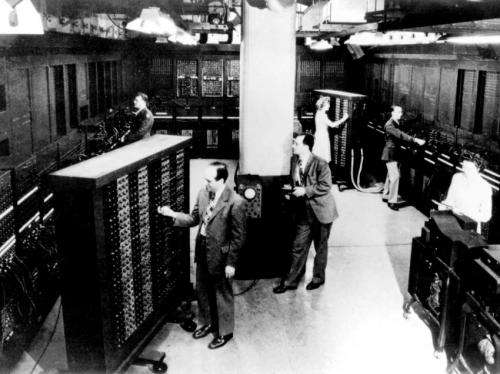November 26, 2014 weblog
ENIAC panels go on display at Oklahoma museum

We keep up with history of events through the calendar, marking special days: Amelia Earhart's birthday, the collapse of the Berlin Wall; the assassination of JFK. Another path is through narrative. An eye-catcher from Gizmodo was "How Ross Perot saved the world's first electronic computer"— or, from Wired, "How the World's First Computer Was Rescued From the Scrap Heap." In 2006, Ross Perot said that his Plano, Texas, headquarters should have relics from computing history. He was, after all, the man behind Austin-based Perot Systems, the well-known IT services provider. Perot's staff sought to acquire a chunk of ENIAC, the Electronic Numerical Integrator And Computer. (ENIAC, said Adam Clark Estes in Gizmodo, is to computing history what the Magna Carta is to legal history or, what the Lawton Constitution calls "The granddaddy of all computers.") ENIAC is regarded as the first true computer and it was refurbished.
This year the good news is that ENIAC's revived panels are accessible to the public for the first time, on public view at the US Army's Field Artillery Museum in Fort Sill, Oklahoma. Field Artillery Museum Director Gordon Blaker in talking about the Perot team's project leads, said in The Lawton Constitution that "They got it all cleaned up. They got it so lights work. They got a lot of the cabling, vacuum tubes, and they just did a fantastic job of refurbishing it." Wired said, "The ENIAC panels went on display at Fort Sill in late October, though some more restoration work remains to be done."
The Smithsonian said the machine booted up in November 1945, "when 300 neon lights attached to accumulators lit up a basement room," and two "20-horsepower blowers exhaled cool air so that ENIAC wouldn't melt down."
The Smithsonian also provided details about the machine. "Weighing in at 30 tons, the U-shaped construct filled a 1,500-square-foot room. Its 40 cabinets, each of them nine feet high, were packed with 18,000 vacuum tubes, 10,000 capacitors, 6,000 switches and 1,500 relays. Looking at the consoles, observers could see a tangle of patch cords that reminded them of a telephone exchange."
ENIAC was mostly used for military research, according to The Lawton Constitution. Its purpose was to provide the Army a better way of computing artillery firing tables, which involve a round's trajectory. Required considerations were factors such as weather, humidity, temperature, wind direction and altitude, which could have a bearing on the flight of the round. "Doing that manually was very time consuming, and they needed a quicker way to do it, and that was what led to the development of ENIAC," said Blaker.
ENIAC was declared by the Army as obsolete in 1955; its panels were divvied up and much of ENIAC vanished into disorganized warehouses, said Wired. Oklahoma's Fort Sill, home to the Army's field artillery museum, though, possessed a large trove of ENIAC hardware, nine panels in total, stored in wooden crates.
Said Engadget: "The museum piece won't replicate the 1945 system in its full glory (it's missing most of the 40 original panels), but it'll give you a sense of what you missed. Restoration gurus Dan and Jonathan Gleason linked hundreds of bulbs to a motion sensor to make it look active when you wander by."
© 2014 Tech Xplore



















